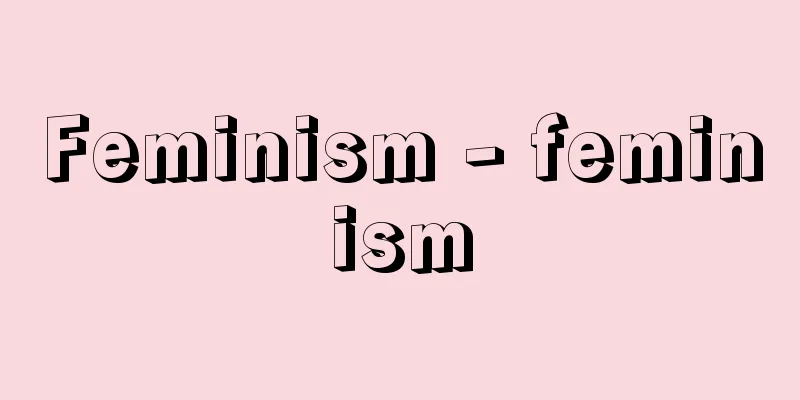Feminism - feminism

|
The word originates from the Latin femina (woman) and is generally translated as the expansion of women's rights or respect for women. Feminism was heavily influenced by the human rights ideas that became the ideology of the French Revolution, and developed in countries such as France, the UK, and the US. The first comprehensive work to advocate feminism was the British thinker M. Wollstonecraft's A Vindication of the Rights of Woman (1792). While questioning J. J. Rousseau's view of women, the work advocated for the mental and economic independence of middle-class women, and contained the seeds of the claims that later feminism put forward, such as equal opportunities in education and work, and the demand for suffrage. Feminism does not have a single theoretical system, and is basically influenced by the historical characteristics and circumstances of each country, and its lineages are divided into various branches. For example, there is a lineage that is more appropriately translated as respect for motherhood or defense of motherhood than respect for women. This is the idea of women's liberation represented by Swedish thinker E. Kay. Kay advocated the defense of motherhood from the standpoint of evolutionary theory, sharply criticized the capitalist society that destroys motherhood, and strongly advocated the realization of equal opportunities in education, economics, and politics, and had a strong influence on feminism in Scandinavian countries and Germany. In Japan, the influence can be seen in the development of feminism before World War II, represented by Raicho Hiratsuka. On the other hand, feminism centered on the United States and the United Kingdom from the mid-19th century to the early 20th century developed around legal equality, represented by the acquisition of suffrage. It is generally called first feminism (or old feminism). In contrast, second-stage feminism (or new feminism), which emerged after World War II, especially in the late 1960s, was heavily influenced by the women's liberation movement, centered in the United States, and was defined as "human liberation by women," with criticism of "women's theory" based on Marxism and the idea of unifying feminism and Marxism as its underlying current. It opposes and aims to eliminate all forms of discrimination and inequality, including political, economic, social, cultural, and psychological, that stem from gender differences. It is particularly characterized by its denunciation of sexual oppression and sexism that are deeply embedded in people's consciousness and lifestyles. However, second-stage feminism has split into several currents over the issue of what is the most fundamental form of oppression for women. Representative currents include radical feminism, which considers the domination of women by men to be patriarchy and asserts that it exists beyond the differences in economic systems, Marxist feminism, which focuses on the capitalist mode of production that is established with unpaid housework as an essential prerequisite, liberal feminism, which sees women's subordination as the sum of many small deprivations, and socialist feminism (integration theory), which aims to combine radical feminism and Marxist feminism and does not focus on either patriarchy or capitalism, but sees patriarchy as providing systems such as control and law and order, and capitalism as providing systems for the pursuit of economy and profits, and asserts that the existence of both is important in the formation of gender relations today. The word feminism is often used to include both an ideology and a movement. [Akiko Fuse] "A Vindication of the Rights of Woman" by Mary Wollstonecraft, translated by Shirai Takako (1980, Miraisha)" ▽ "The Women's Movement" by Ellen Key, translated by Harada Minoru (1924, Shueikaku)" ▽ "Love and Marriage" by Ellen Key, translated by Onodera Makoto and Onodera Yuriko (Iwanami Bunko)" ▽ "In the Beginning, Women Were the Sun: Hiratsuka Raicho's Autobiography," 4 volumes (1971-72, Otsuki Shoten)" ▽ "An Introduction to Women's Liberation Theory, edited by Ichibankase Yasuko (1975, Aki Shobo) " ▽ "Sexual Politics" by Kate Millett, translated by Fujieda Mioko (1985, Domesu Publishing)" ▽ "Juliet Mitchell, Ann OakleyWhat is Feminism? (1986, Pantheon Books)" ▽ Between Money and Love: The Development of Marxist Feminism, by Natalie J. Sokoloff, translated by Ehara Yumiko et al. (1987, Keiso Shobo) Modern Family and Feminism, by Ochiai Emiko (1989, Keiso Shobo) Sylvia Walby Theorizing Patriarchy (1990, Blackwell Pub.) Fin de Siecle Feminism: Women from Four Countries, by Susan Basnett, translated by Shindo Kumiko (1993, Tabata Shoten) Japanese Feminism, edited by Inoue Teruko et al., 7 volumes and supplements (1994-95, Iwanami Shoten) Feminism, edited by Ehara Yumiko and Kanai Yoshiko (1997, Shinyosha) [References] | | | | | | | | | | |Source: Shogakukan Encyclopedia Nipponica About Encyclopedia Nipponica Information | Legend |
|
ラテン語のfemina(女性)から発生したことばであり、一般に女権拡張主義、女性尊重主義と訳される。フェミニズムは、フランス革命の理念となった人権思想の影響を色濃く受け、フランス、イギリス、アメリカなどの諸国において発達した。フェミニズムを主張する最初のまとまった著作としては、イギリスの思想家M・ウルストンクラフトの『女性の権利の擁護』(1792)があげられる。J・J・ルソーの女性観に疑問を投げかけつつ、中産階級の女性の精神的自立と経済的自立を主張したその展開には、教育・職業の機会均等、参政権獲得要求など、以後のフェミニズムが掲げた主張の萌芽(ほうが)が集約されている。 フェミニズムには単一の理論体系があるわけでなく、基本的には、それぞれの国の歴史的特徴、情勢の影響を受け、系譜も多様に分かれる。たとえば、女性尊重主義という訳語よりも、母性尊重、母性擁護という訳語が妥当な系譜がある。それは、スウェーデンの思想家E・ケイに代表される女性解放思想である。ケイは、進化論の立場から母性の擁護を訴え、母性を破壊する資本主義社会を鋭く批判、教育、経済、政治における機会均等の実現を強く主張し、スカンジナビア諸国やドイツのフェミニズムに強い影響を及ぼした。日本でも平塚らいてうに代表される第二次世界大戦前のフェミニズムの展開にその影響がみられる。一方、19世紀中葉から20世紀初頭のアメリカやイギリスを中心とするフェミニズムは、参政権獲得に代表される法的平等を中心に展開された。一般に第一次フェミニズム(または旧フェミニズム)とよばれる。 これに対し、第二次世界大戦後、とくに1960年代後半以降の第二次フェミニズム(または新フェミニズム)は、アメリカを中心とするウーマン・リブの影響を色濃く受けており、マルクス主義の立場にたつ「婦人論」への批判、あるいはフェミニズムとマルクス主義の統一という発想を底流に、「女性による人間解放主義」と規定され、性差に起因する政治的、経済的、社会的、文化的、心理的など、あらゆる形態の差別や不平等に反対し、その撤廃を目ざす。とりわけ、意識やライフ・スタイルに深く組み込まれた性抑圧、性差別の告発という点に特徴をもつ。 しかし、第二次フェミニズムは、なにが女性にとってもっとも根源的な抑圧であるかという論点をめぐって、いくつかの潮流に分かれている。代表的な流れとしては、男性による女性の支配を家父長制ととらえ、これを経済体制の違いを超えて存在すると押さえるラディカル・フェミニズム、無償の家事労働を不可欠の前提として成立する資本主義的生産様式に焦点をあてるマルクス主義フェミニズム、女性の従属を多数の小さな剥奪(はくだつ)deprivationの総和とみるリベラル・フェミニズム(自由主義フェミニズム)、ラディカル・フェミニズムとマルクス主義フェミニズムの結合を目ざし、家父長制と資本主義のいずれかに焦点をあてるのではなく、家父長制は管理や法・秩序などのシステムを用意し、資本主義は経済・利潤追求のシステムを用意するとみることにより、両者の存在が今日の両性(ジェンダー)関係の形成に重要な意味をもつと押さえる社会主義フェミニズム(統合理論)などがある。フェミニズムということばは、思想と運動の双方が含まれて用いられる場合が多い。 [布施晶子] 『メアリ・ウルストンクラーフト著、白井尭子訳『女性の権利の擁護』(1980・未来社)』▽『エレン・ケイ著、原田実訳『婦人運動』(1924・聚英閣)』▽『エレン・ケイ著、小野寺信・小野寺百合子訳『恋愛と結婚』(岩波文庫)』▽『平塚雷鳥著『元始、女性は太陽であった――平塚らいてう自伝』全4冊(1971~72・大月書店)』▽『一番ケ瀬康子編『入門女性解放論』(1975・亜紀書房)』▽『ケート・ミレット著、藤枝澪子訳『性の政治学』(1985・ドメス出版)』▽『Juliet Mitchell, Ann OakleyWhat is Feminism?(1986, Pantheon Books)』▽『ナタリー・J・ソコロフ著、江原由美子他訳『お金と愛情の間――マルクス主義フェミニズムの展開』(1987・勁草書房)』▽『落合恵美子著『近代家族とフェミニズム』(1989・勁草書房)』▽『Sylvia WalbyTheorizing Patriarchy(1990, Blackwell Pub.)』▽『スーザン・バスネット著、進藤久美子訳『世紀末のフェミニズム――四つの国の女たち』(1993・田畑書店)』▽『井上輝子他編『日本のフェミニズム』全7巻・別冊(1994~95・岩波書店)』▽『江原由美子・金井淑子編『フェミニズム』(1997・新曜社)』 [参照項目] | | | | | | | | | | |出典 小学館 日本大百科全書(ニッポニカ)日本大百科全書(ニッポニカ)について 情報 | 凡例 |
Recommend
JANA
Jamahiriya News Agency . Libya's state-run new...
Kralicky Sněžník
…It has numerous tributaries and a drainage area ...
Bodenstein, EAM (English spelling) BodensteinEAM
…The progress of reaction kinetics was also remar...
Laval, C. (English spelling)
…Gauguin's Vision after the Sermon (1888) is ...
Kastorias [Lake] - Kastorias
…Ancient name: Keletron. Located on the west shor...
Shinzo Oya
1894-1980 A businessman and politician from the S...
Dioxazine pigment - Dioxazine pigment
Dioxazine itself is a purple dye that has been kno...
Takamine Jokichi
Year of death: July 22, 1922 Year of birth: Novemb...
Cassini, J.
…He was invited to join the newly established Aca...
Momoishi [town] - Momoishi
A former town in Kamikita District, eastern Aomori...
démence précoce (English spelling) demenceprecoce
… The concepts that lead to today's schizophr...
"Grammar of the Movie"
...However, Soviet filmmakers such as Pudovkin an...
Carettochelyidae
…Also known as the New Guinea soft-shelled turtle...
Isagoras
…At that time, Sparta was trying to overthrow a n...
Hērophilos
A Greek surgeon and anatomist who lived in Alexand...









